Pisnyi Borshch (пісний борщ) is a special meatless version of borscht from Ukraine. It’s traditionally eaten on Christmas Eve, when most animal products are not allowed under the Orthodox Christian religion. But don’t limit yourself to just Christmas—this vibrant crimson soup, which can be eaten hot or cold, is enjoyed all throughout the year. Vegan borscht tastes even better the next day, after it’s had time to rest in the fridge, making it ideal for everyday meal prep as well as for celebrations. Aka, how to get your daily dose of veggies without feeling like it’s a chore!
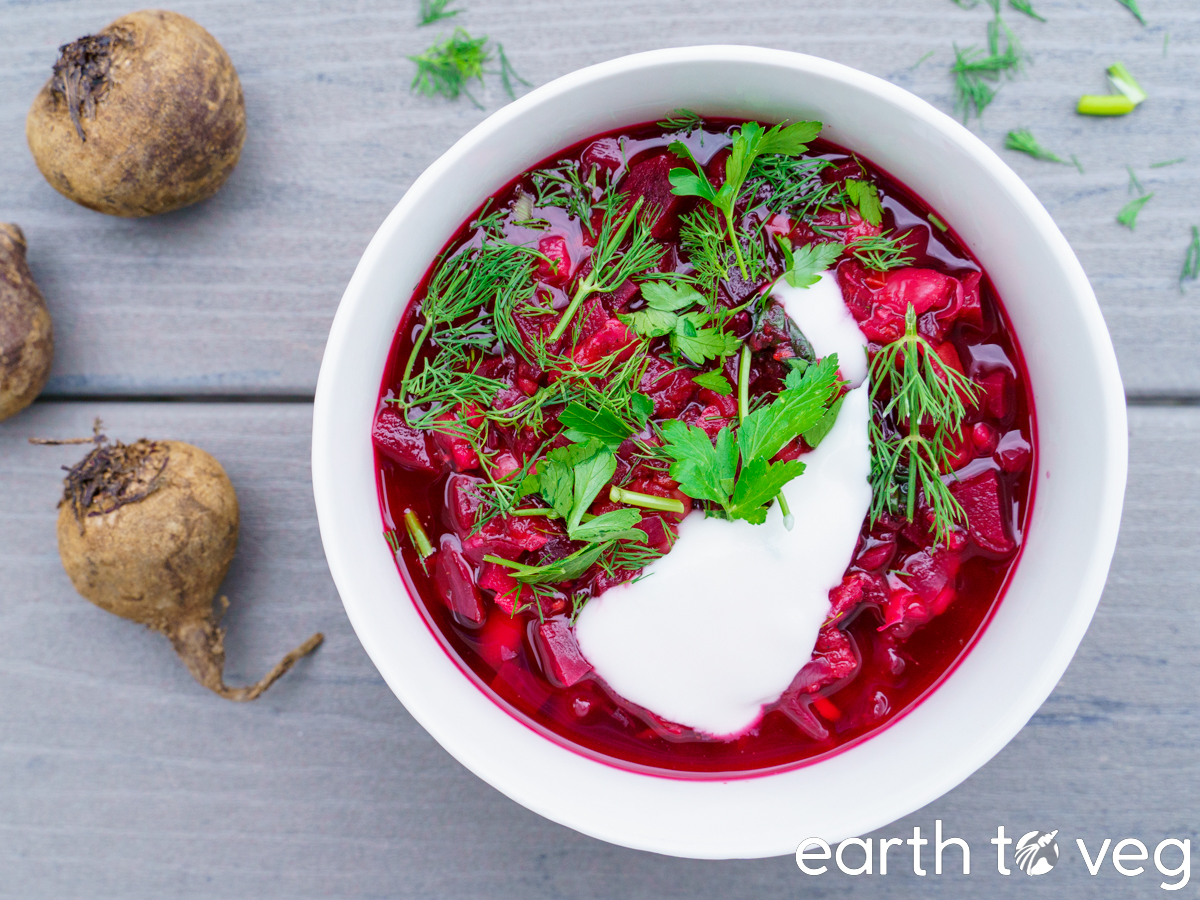
Borsht vs Borscht vs Borsch vs Borshch
First, let’s clear up the spelling. There are so many damn consonants at the end of this word. What’s more confusing is that there are a number of different ways to spell it, some of which are more correct than others, depending on who you talk to.
Here are four of the most common variants:
- Borsht: the literal translation of the Yiddish word, באָרשט.
- Borscht: the most common spelling used in North America. Derived from the Yiddish name for the dish, because it was Ashkenazi Jewish immigrants who popularized this dish in the United States. It generally refers to a Yiddish or Ukrainian version of the soup, made with beets, like the one in this post.
- Borshch: the literal translation of the Ukrainian and Russian word, борщ. You will please the most amount of people and avoid getting flamed if you use this spelling. Many Russian and Ukrainian speakers take issue with including t at the end of borscht.
- Borsch: another acceptable alternative, similar to borshch.
For the rest of this post, I will be using all four versions of the word interchangeably.

History & Origins
These days, borshch is synonymous with Ukrainian and Russian cuisine, and just about every Eastern European country eats some variant of this soup. Besides perogies, it’s probably the dish that the region is most famously associated with. But where did borsch come from, originally?
This is a very contentious question, but most historians agree that borscht was first made in Ukraine. It has humble origins, originally made from fermenting a plant called hogweed or cow-parsnip (real appetizing, I know) to give it its sour flavour. Indeed, the name of borscht is derived from bŭrščǐ, an ancient Slavic word for hogweed.
Most Americans consider borshch—usually transliterated as borscht—distinctively Russian. It’s true that the appearance of this garnet beet soup in American life coincided with a massive late-nineteenth-century immigration from Russia. But the immigrants who brought borscht to our tables were not Russians; they were Jews from the Pale of Settlement, an area that stretched along the western edges of the Russian Empire and included much of present-day Ukraine. Borscht is, in fact, the Ukrainian national soup.
– Darra Goldstein, Beyond the North Wind: Russia in Recipes and Lore
Since its creation in the Early Middle Ages, borsch has become popular all over the world. Much like Olivier Salad, another holiday recipe with roots in Eastern Europe, it’s gained a global presence. You can find borscht under the following names:
- борш (borshch) in Bulgaria, Russia, Ukraine
- Բորշ (borsh) in Armenia
- Боршч (boršč) in Belarus
- Boršč in Bosnia, Croatia, Slovakia, Slovenia
- 罗宋汤 (luó sòng tāng) in China
- ბორში (borshchi) in Georgia
- Barščiai in Lithuania
- Barszcz in Poland
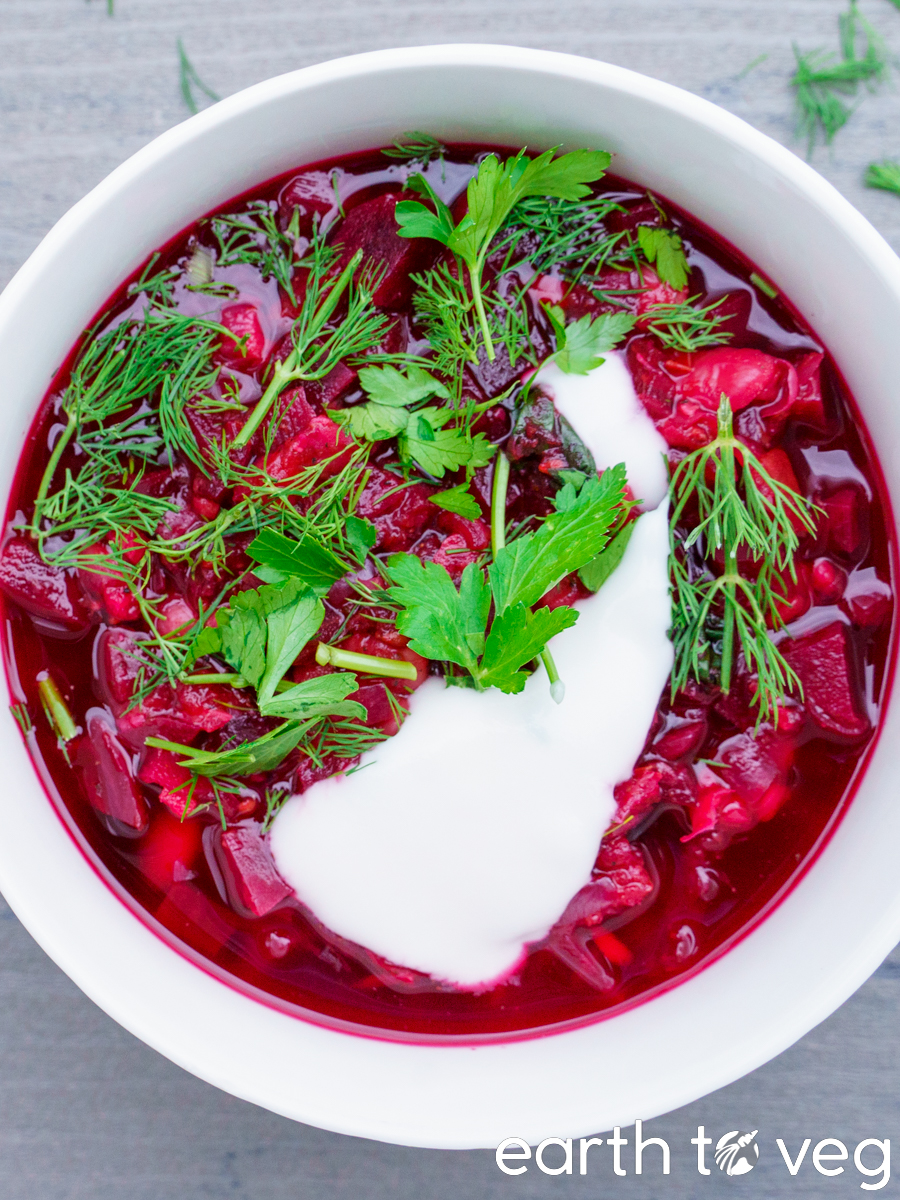
Can something as eternal and variable as borscht have a history? Of course it can, and that’s where a simple thing becomes complicated—in other words, political. Just as Russians and Ukrainians both lay claim to being the true heir of the proto-Slavic medieval kingdom known as the Kyivian Rus, so it is with borscht. Is it Ukrainian or Russian? Or does it belong to the Poles who also say it originated with them? It doesn’t matter. In politics, the debate about who belongs where and to whom is often unpleasant, as current events suggest. But when it comes to food it’s an argument not worth having becauase like so many of the things we eat, borscht has been shameless ingredient-shifting and promiscuous in its migrations.
– Bryan Demchinsky, Borscht – A Love Story
What Makes a Borshch
You may think that beets are the defining feature of borshch, but that’s not true! In fact, there are many recipes for borsht that don’t feature beets whatsoever. The unifying characteristic of all borsht soups is their sour taste. This is traditionally achieved with kvass, a traditional drink made from fermented beets. However, you can find borschts soured with tomatoes, vinegar, lemon juice, pickle juice, sauerkraut, and many more.

Ukrainian Pisnyi Borshch
Ukraine has dozens of different borsch recipes that vary between provinces and even cities. This vegan pisnyi borshch uses tomatoes only for the souring agent. It’s not super sour, so it will appeal to everyone, even those who are new to borsch. I’m currently working on a kvass recipe and after I finish that I will be posting another recipe for kvas borshch which will be more sour.
Chinese Borscht
Another variant that shows the adaptability of borscht is luo song tang, or Chinese borscht. In Chinese, we call it 羅宋湯 which literally means “Russian soup.”

When Kevin told me he was a big fan of borscht, I was like WHAT?!?!? because I know he hates beets. Then when we went to this HK style café in Richmond and he showed me the borscht soup he always orders, it all made sense.
You see, Chinese borscht became a thing during the mid-20th century, after the Russian Revolution left the Communist Party in power. Russians who opposed the new regime were called White Russians (in contrast to the “red” communists). White Russians emigrated abroad en masse, including to China. This led to an infusion of Russian-inspired recipes into Chinese cuisine. Chinese borscht uses tomatoes, does not contain beets, and I don’t think I’ve ever seen it served with dill or sour cream. Diners pair it with a buttery soft dinner roll that they dip into the soup, soaking up the savoury broth.
Canadian Borsch
And let’s talk about Canadian borshch too. I grew up in one of the prairie provinces, where there is a large Ukrainian population. We also have a lot of Mennonites and Doukhobors both of whom consume borsch as a traditional food. So, you can imagine there are tons of different recipes for borshch enjoyed on the Canadian prairies. One of the sources I used for this recipe was Traditional Ukrainian Cookery, the classic authority on Ukrainian cuisine, written by the late Savella Stechishin from Saskatoon.
Root vegetables such as potatoes, beets, and carrots, more immune to smelter smoke and frost, were extracted from the earth, as was dill, which is rightly called a weed. Tomatoes could be bought if not grown. And so there was always borscht.
– Bryan Demchinsky on Canadian pioneer life in Borscht – A Love Story
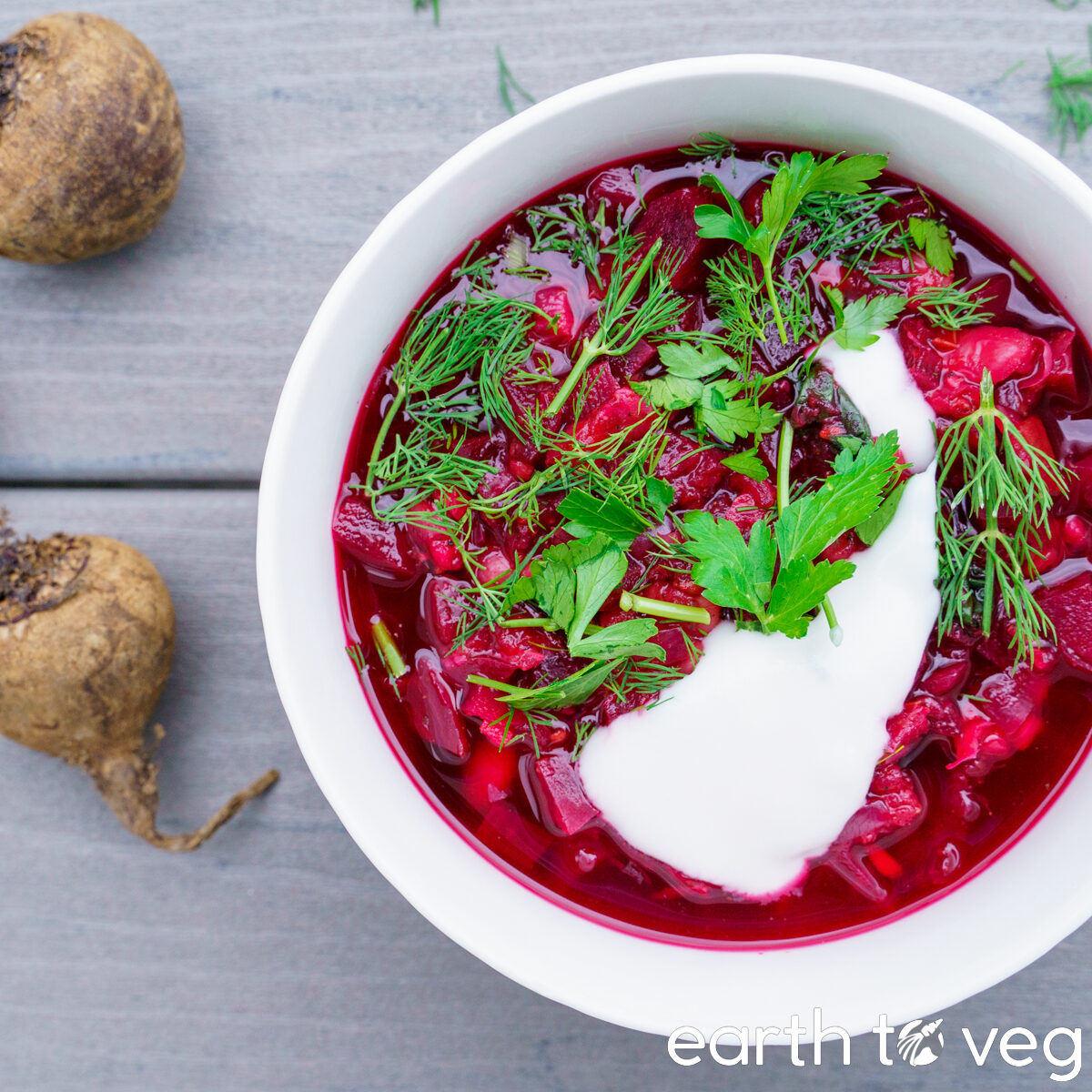
Sviaty Vechir (Ukrainian Christmas Eve)
Sviaty Vechir (Святий Вечір) is Ukrainian for “Christmas Eve.”
In many Eastern European countries, observant Eastern Orthodox Christians celebrate this day with an elaborate 12-course “meatless” meal. (Why is “meatless” in quotation marks? Because although the religious rules prohibit most animal products, fish are an exception. A traditional Sviaty Vechir dinner is typically not vegan due to the seafood component.)
Borsht is an essential component of this 12-course dinner. It’s usually the second course. Because of the fasting requirement, the version eaten for Sviaty Vechir is called pisnyi borshch or “lean borscht” because it steers clear of the butter, meat, and sour cream that are found in most borsches. Therefore, pisnyi borshch is a great choice for vegans, as long as you avoid any fish stock in the broth!

Christmas Borscht
Besides the lack of meat, two things about Christmas borscht set it apart from other borscht varieties.
- Vushka dumplings: In Poland and Ukraine, Christmas borsch is topped with uszka or vushka (literally, “little ears”) which are petite dumplings stuffed with sautéed mushrooms.
- Clear soup: Another thing, the borshch served on Christmas Eve is strictly speaking supposed to be a clear soup. That means straining out the vegetables before serving. (It’s acceptable to keep the beets.) I couldn’t bring myself to do this, not only because there’s so much nutrition still in those veggies but also because THEY TASTE GOOD. So, I left them in. Yeah, I guess I’m a heretic. If you want to be very authentic, pour the soup through a strainer and discard the vegetables, keeping only the clear broth. (I wonder if this is done to keep diners from getting too full from one soup. After all, there’s 11 other dishes to go through…)

What You’ll Need
I know, the ingredient list for pisnyi borshch looks long, but every ingredient is worth having.
A generous glug of sunflower oil makes this soup rich and hearty. Sunflower oil is one of the most popular cooking fats in Eastern European cuisine, it’s basically the all-purpose vegan substitute for butter and lard. You could also use other neutral-tasting cooking oils like avocado, canola, grapeseed, vegetable oil, etc. I don’t really recommend extra virgin olive oil because it has a distinctive taste which does not really belong in borshch. A light olive oil would be okay though.
Garlic, onion, celery, and cabbage provide the aromatic flavour base of vegan borshch while adding body. For a more sour taste, you can sub a half cup of packed sauerkraut (around 110g) in place of the fresh cabbage.
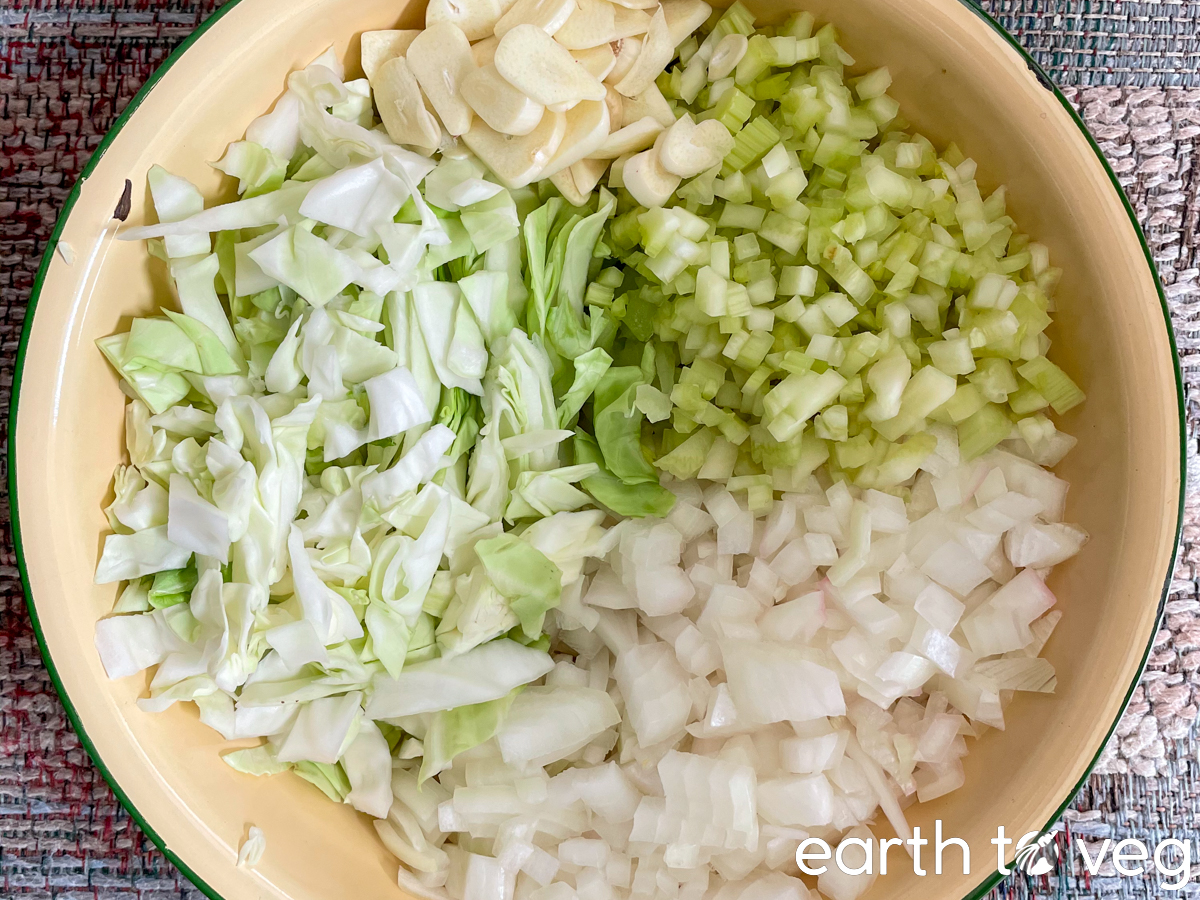
Beet roots and leaves: When I buy beets, they sometimes come with the leaves still attached. This is a great recipe for using up both the roots and leaves. But if your beetroots don’t come with the leaves, you can substitute them with 1–2 cups of chopped Swiss chard, or more cabbage, or just leave them out. Grate or shred your beets for the best texture. I’ve tried making this soup with diced beets and it’s just not as tasty.

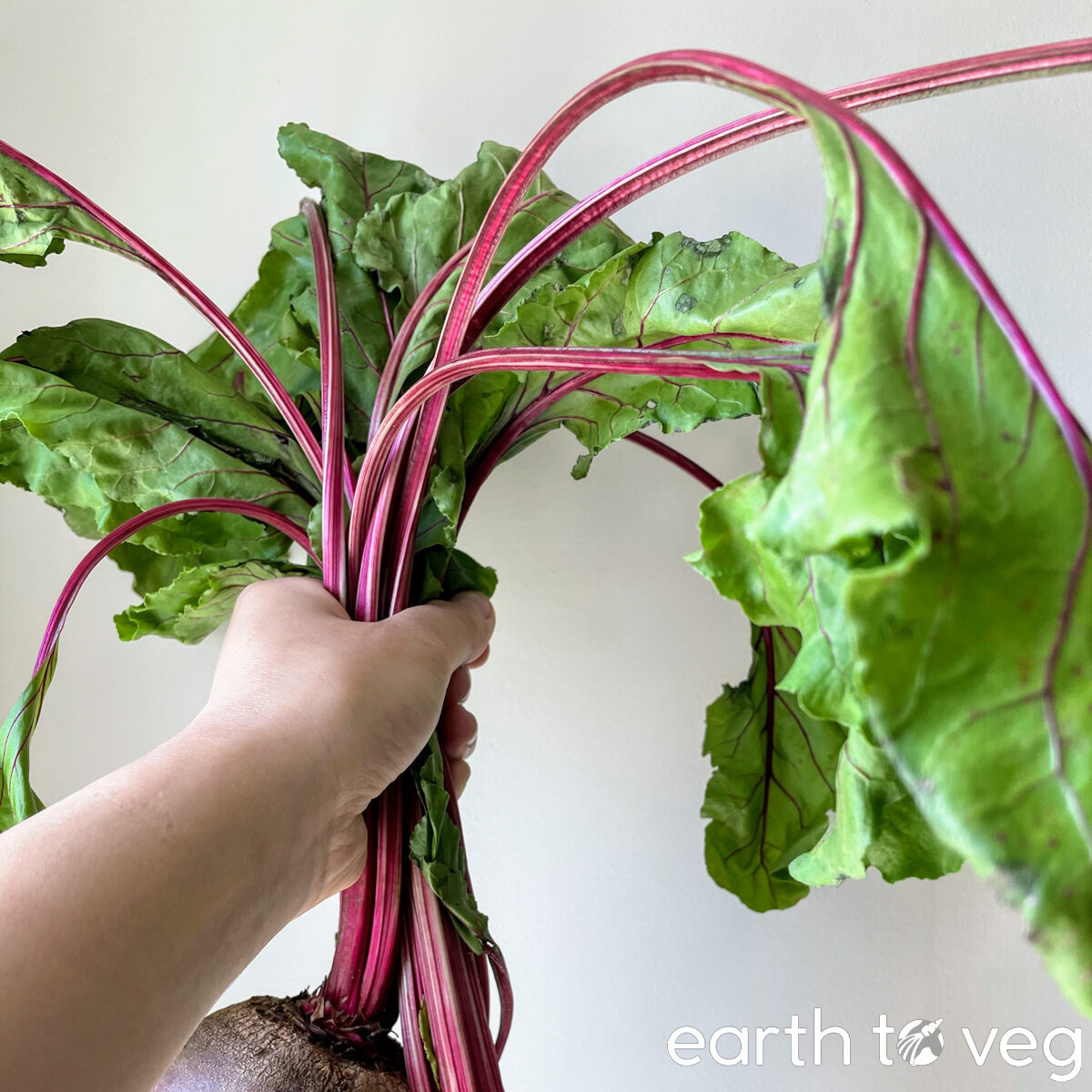

Tomatoes add a delicious umami flavour to the broth as well as providing the necessary sourness that makes a borscht a borscht. You can use fresh chopped tomatoes, diced tomatoes, or crushed tomatoes. As written, this vegan borscht recipe is not super sour, so if you want a more sour flavour you can make the sauerkraut substitution for cabbage mentioned above, and/or sprinkle in some lemon juice, vinegar, or tomato juice at the end of cooking. (VERY IMPORTANT to add these after cooking, not before, because acid inhibits vegetables from softening, and vegetables that are firm to the bite make for a rather unsatisfying borsch.)

The spices for borscht are simple: salt, bay leaf, paprika, black pepper, and just a hint of allspice. Leave out the paprika and allspice if you don’t have any. Using whole peppercorns instead of ground pepper avoids getting little black specks all over your soup, which keeps the borsch clear. Same with the allspice berries. But by all means, use ground spices if that’s all you’ve got. It won’t impact the flavour of your meal, just the appearance.
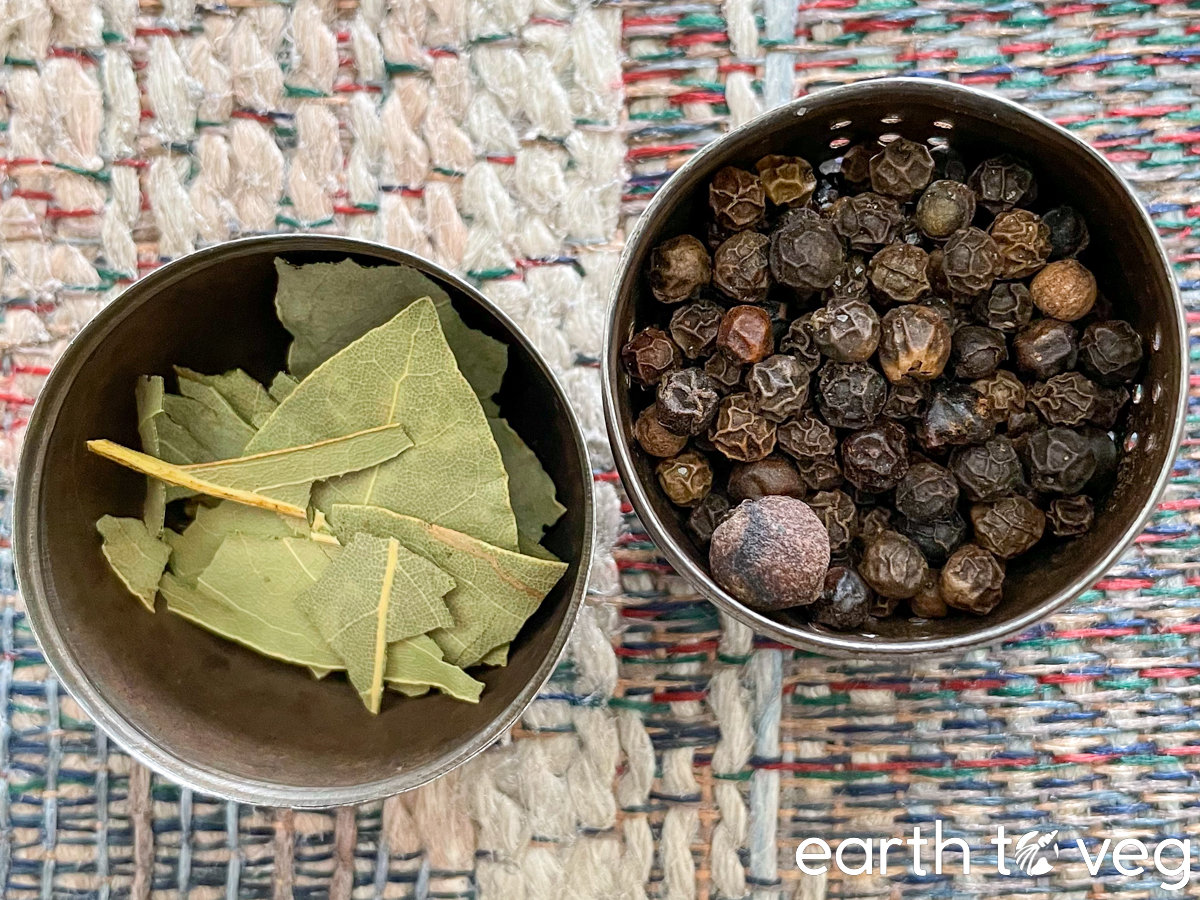
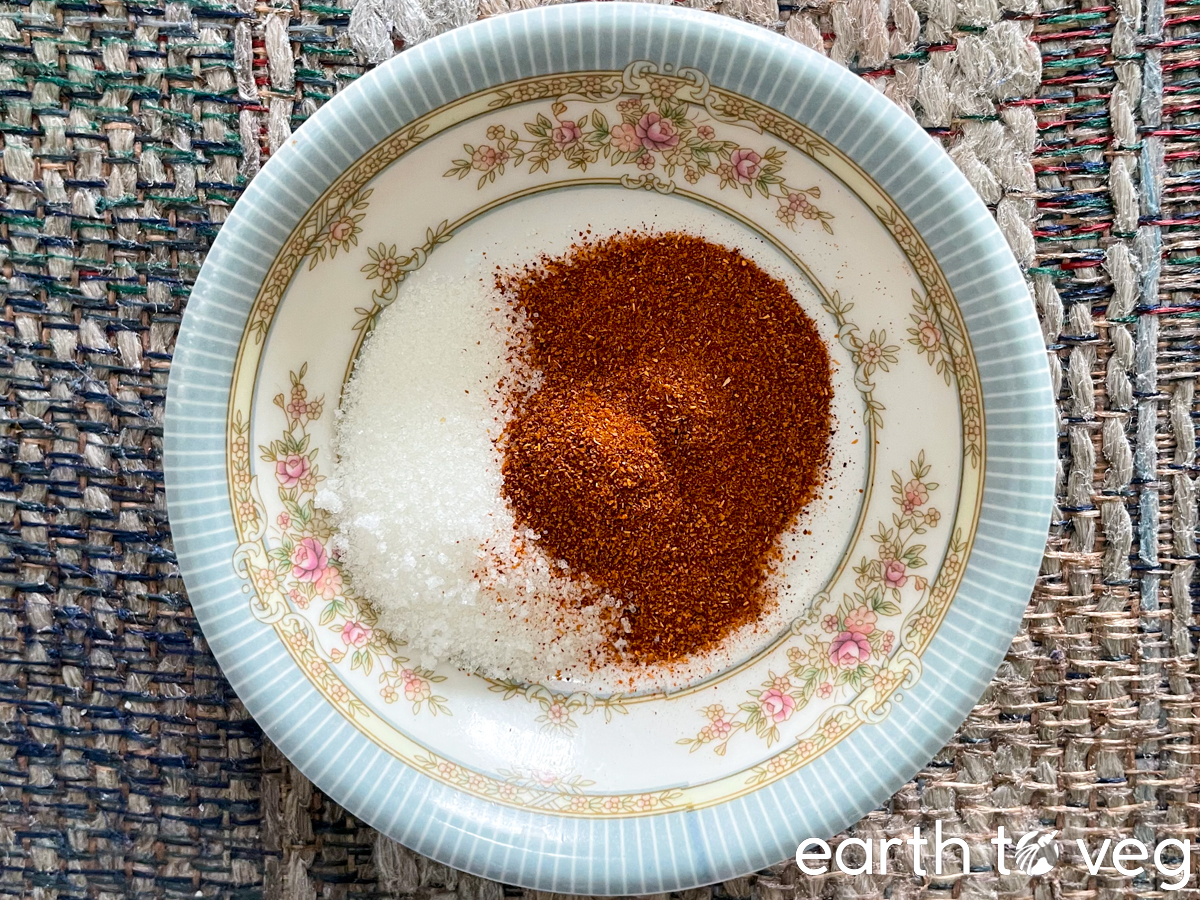
How much water or vegetable stock to add depends on your preference. There’s an old saying in Ukraine that a proper borscht should be so thick that a wooden spoon can stand up in it. Start with 1 qt of liquid (960g), and add more to thin it out when serving. I personally prefer a thinner borsch, so I end up adding 1–2 cups of water.
Ukrainians eat borsch with fresh dill and parsley and lots of sour cream. Sour cream is not traditional for the Christmas borscht because dairy products are not permitted, but you could use vegan sour cream if you want.
Step-by-Step Process
Note: the process photos below are for the Instant Pot method. However, if you’re making vegan borshch on the stovetop, the steps are the same, except that instead of pressure cooking for 10 minutes you will be simmering for 45 minutes.
First, heat up your pot. Instant Pot: hit the button for the Sauté function on your Instant Pot on Normal mode (don’t cover with the lid). Stovetop: Set a stockpot or Dutch oven on medium heat on your stove.
Pour in the sunflower oil, then add garlic, onion, celery, and cabbage. Cook for around 5 minutes or until onions have softened and cabbage has wilted, stirring occasionally to prevent burning on the bottom.
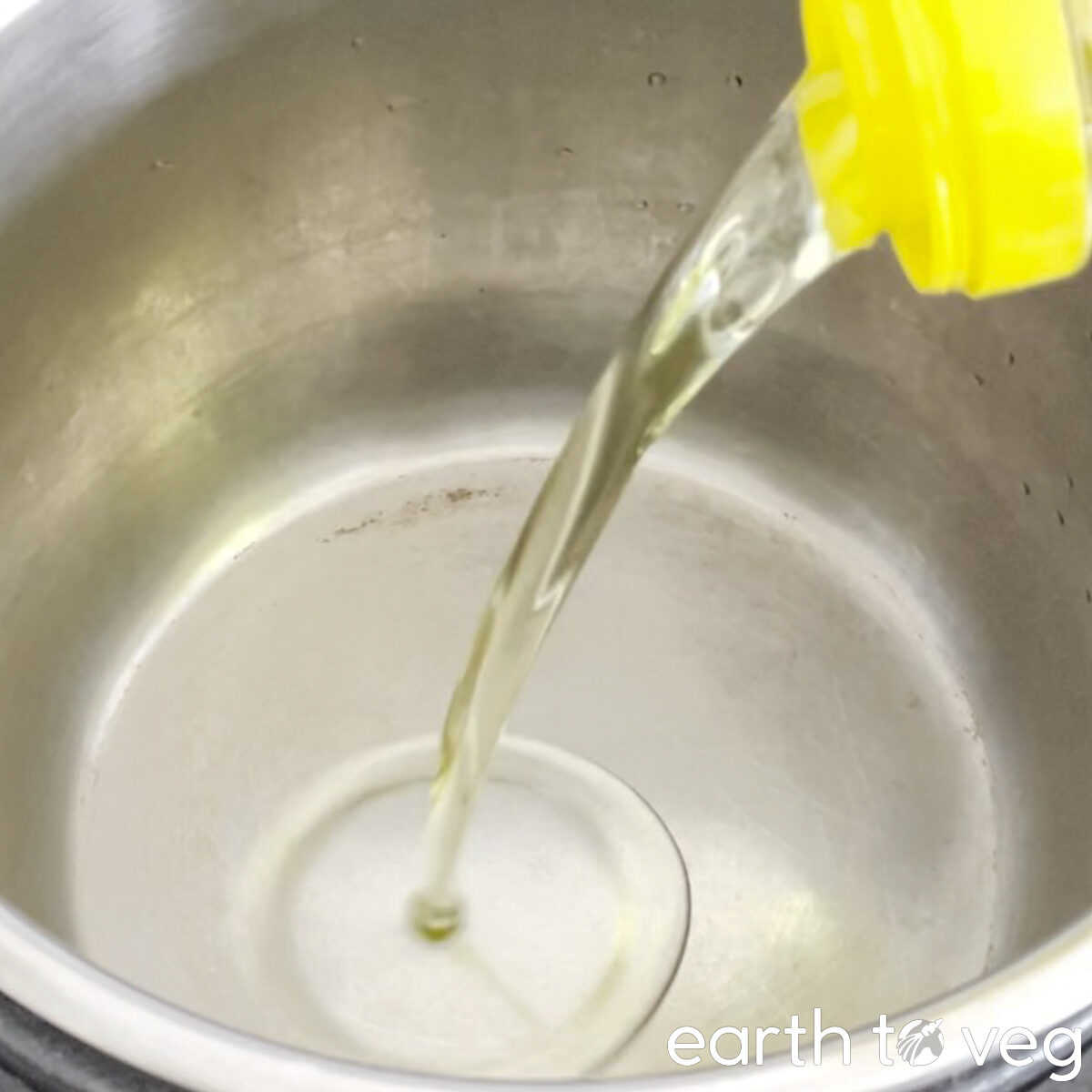

Next, throw in the beet roots and leaves. Cook for another 5 minutes. You may need to stir more often at this point, to prevent the beets from sticking.
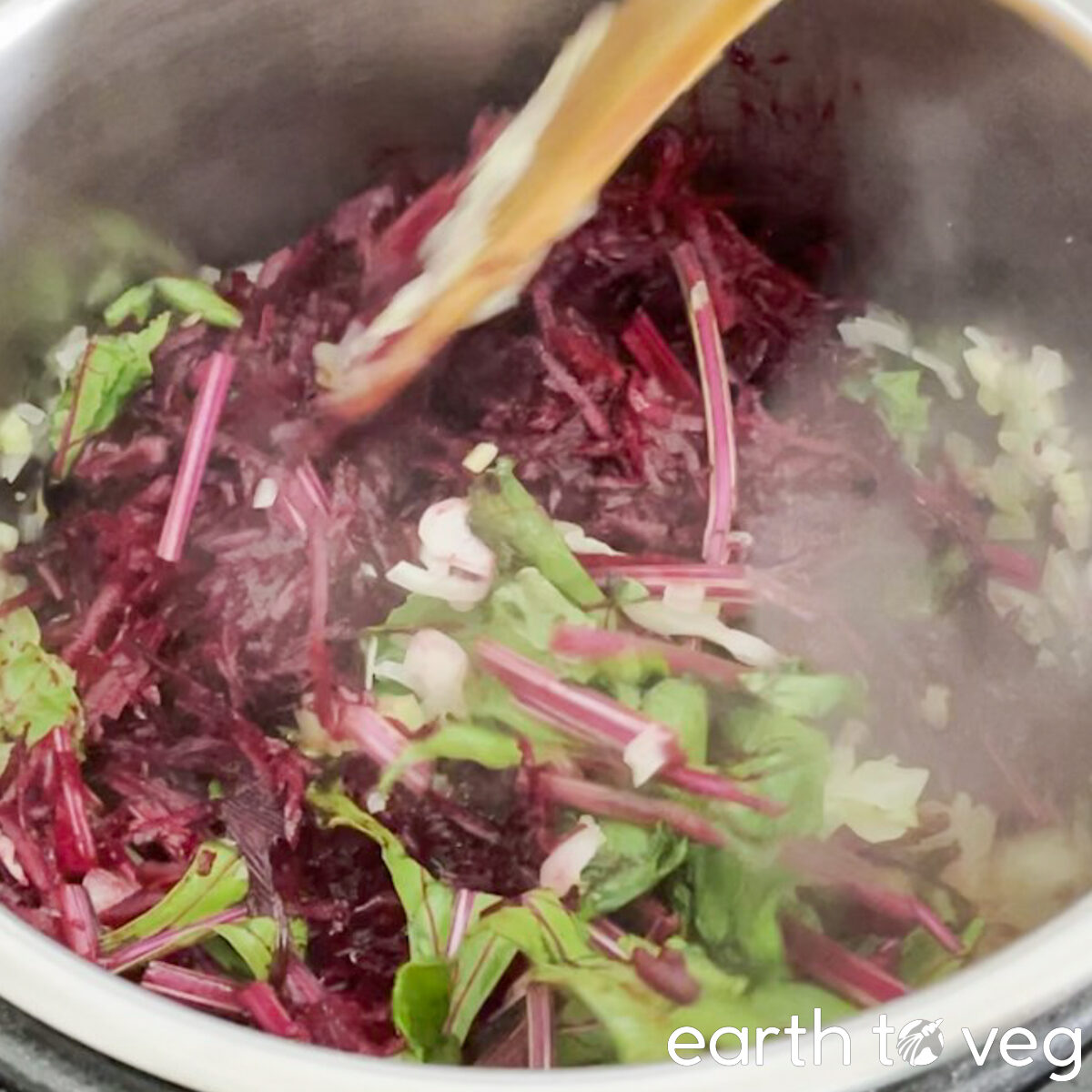
Now add the tomatoes and spices, and pour in your water or vegetable stock.
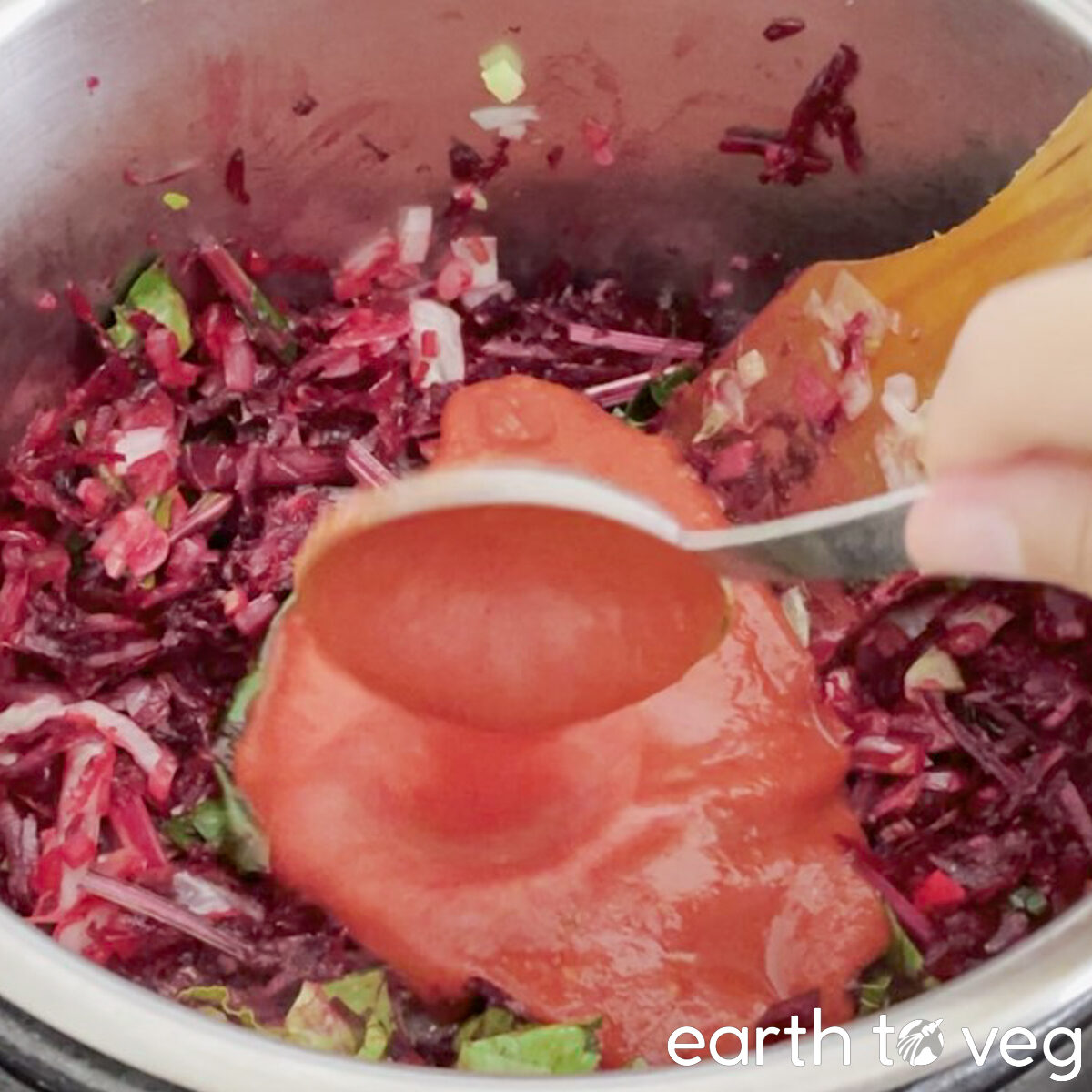



Instant Pot: time to pressure cook. Lock the lid onto your pot, then press the Soup button and set it for 10 minutes on High Pressure. Stovetop: cover your pot, then turn the heat all the way up and bring it to a boil. Once it starts bubbling, drop the heat back down to low and keep it there to allow the soup to remain at a gentle simmer for 45 minutes.
Instant Pot: once the Instant Pot beeps, turn it off and let the pressure release for 20 minutes, then turn the valve to release all remaining pressure. Stovetop: after 45 minutes is up, turn off the heat but keep the pot on the stove. Let it rest for 10 minutes before uncovering.
Give the soup a good stir, scoop out the soup bag/tea infuser thing if you used it, then ladle into bowls and top with dill and parsley. смачного!

Make Ahead & Storage Tips
Borscht is one of those dishes that tastes better the next day. I mean, I usually eat it the day of cooking because I’m impatient, but what I’m saying is that it’s totally okay to have leftovers for this recipe. You can even freeze vegan borscht with no problems. Store it in an airtight container in the fridge for up to five days, or in the freezer for 3 months. (Technically, it can go even longer, but food gradually loses its flavour during prolonged stays in the freezer. Plus the risk of freezer burn increases. So try to finish it within the first 3 months).
It is always better to let borshch sit for a few hours for the flavors to marry, or easier yet, make it the day before.
– Annette Ogrodnik Corona, The New Ukrainian Cookbook
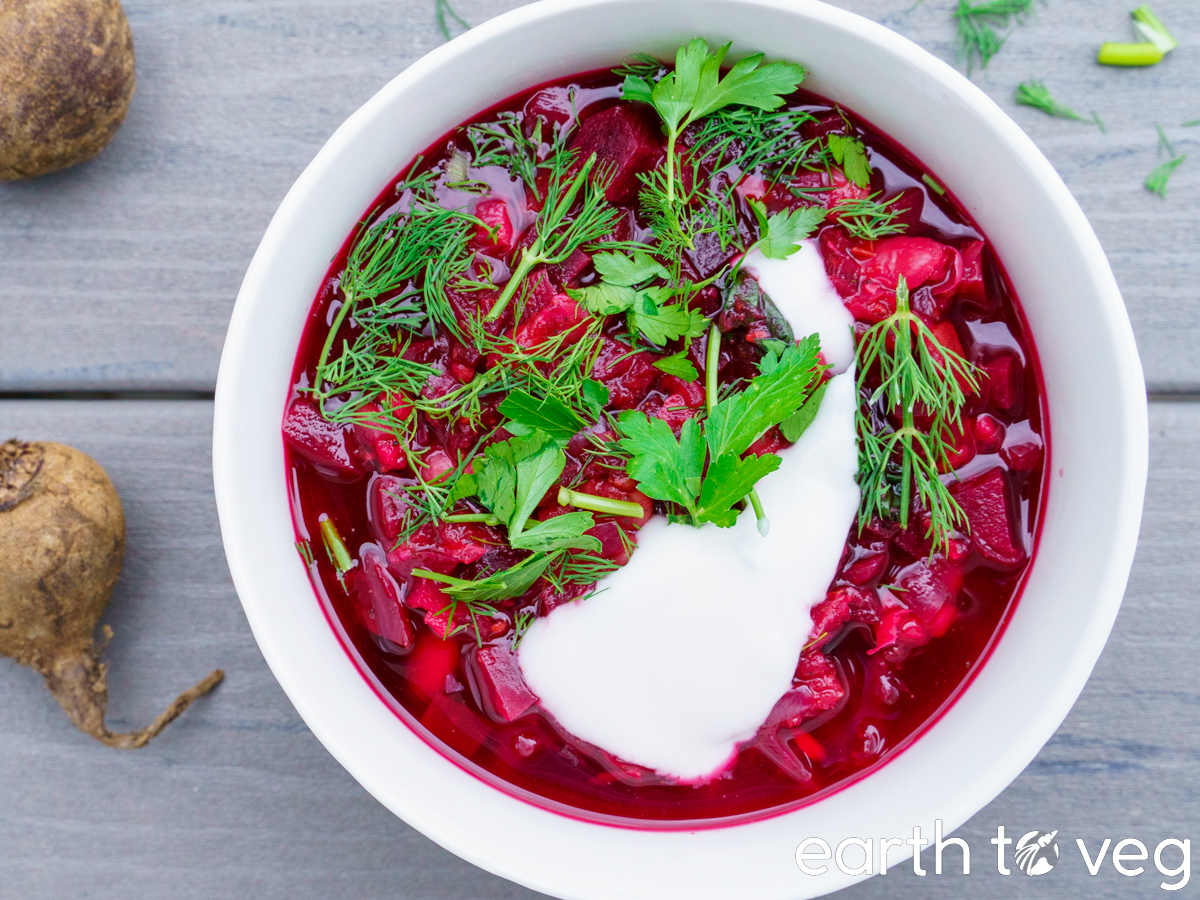
More Eastern European Recipes

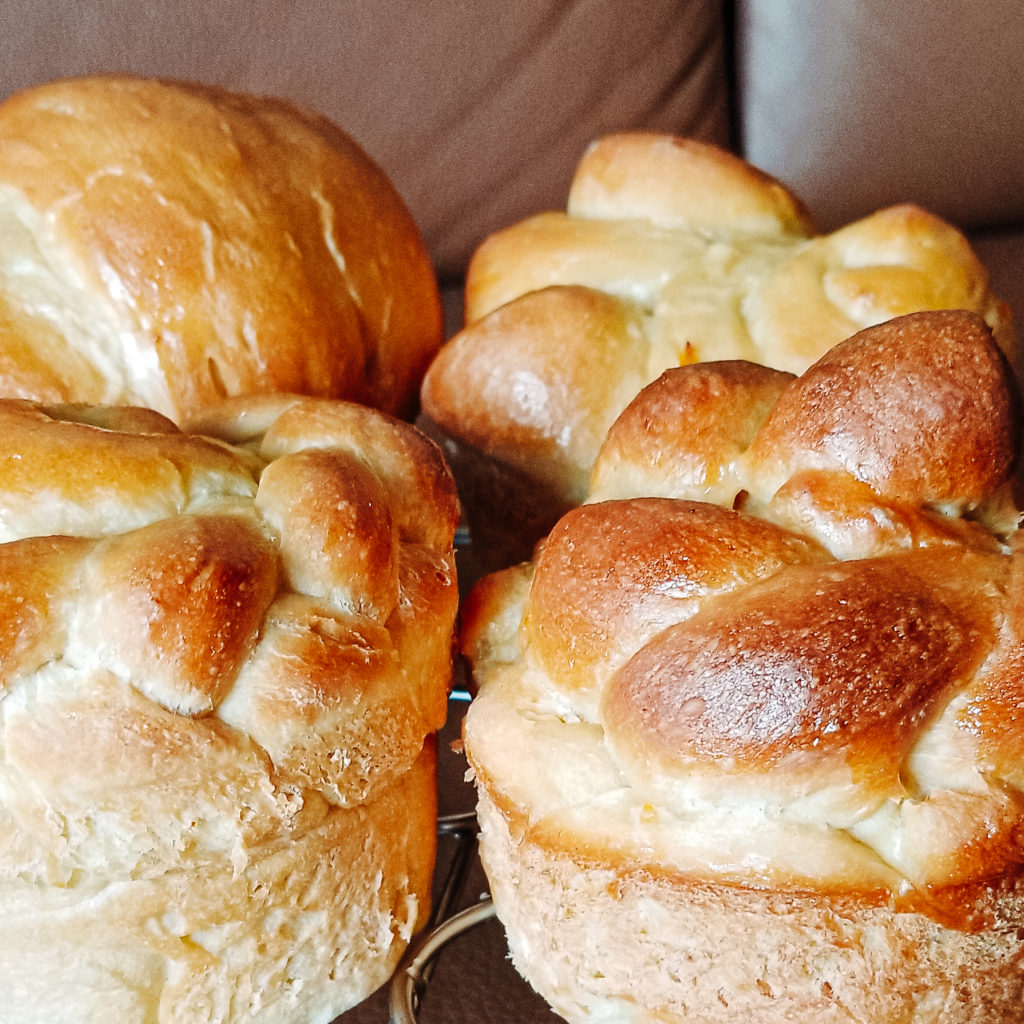

Recipe Card
Did you make this recipe? Please consider leaving a rating below to let me know how you liked it.
You can also take a picture and tag me on Instagram @earthtoveg, I will shout you out in my Stories!

Meatless Borscht Soup (Pisnyi Borshch) пісний борщ
Use Imperial/Metric buttons below to toggle between volume vs weight measurements. I recommend weighing out your ingredients for best results.
Equipment
- Instant Pot (or stockpot, if using Stovetop option)
Ingredients
- ¼ cup sunflower oil see Note 1
- 3 cloves garlic, sliced thin
- 1 onion, finely diced
- 2 ribs celery, finely diced
- ⅛ head green cabbage, chopped *can sub 1/2 cup sauerkraut for a more sour soup
- 3 red beets, shredded or grated
- 1 handful beet leaves, roughly chopped *optional
- 2 fresh tomatoes or 1/4 of a 28oz can, diced
- 1 tsp fine salt or 1/2 tbsp kosher salt 6 g
- 1 tsp ground paprika *optional
- 2 bay leaves
- 1 tbsp black peppercorns or 1 tsp ground black pepper
- 2 allspice berries or 1/8 tsp ground allspice *optional
- 1 qt vegetable stock or water + more for a thinner soup
- ¼ cup fresh dill, chopped
- ¼ cup fresh parsley, chopped
Instructions
- Set the Instant Pot to Sauté function on Normal mode. (Stovetop: put a stockpot or Dutch oven on medium heat.) When the display reads "Hot," pour oil into the pot followed by garlic, onion, celery, and cabbage.
- Sauté for 5 minutes, then add the beets and beet leaves.
- Sauté another 5 minutes, then add tomatoes, paprika, salt, and vegetable stock, and turn off the Instant Pot.
- Put the bay leaves, black peppercorns, and allspice berries into a soup bag or tea ball, then drop it into the pot. (If you don’t have an infuser thingy, I suggest using ground spices instead and remember to fish out the bay leaves when the soup is done cooking.)
- Lock the lid onto the Instant Pot. Press the Soup function and adjust the time to 10 minutes. (Stovetop: cover and bring the soup to a boil, then reduce heat to low and simmer for 45 minutes.)
- When the Instant Pot finishes cooking, allow pressure to release naturally for 20 minutes before releasing any remaining pressure. (Stovetop: turn off the stove and let sit, covered, for 10 minutes.)
- Remove the lid and give everything a stir. Scoop out the soup infuser ball.
- This soup can be eaten hot or cold. Before serving, top with dill and parsley. If you're serving borscht for Christmas Eve, drop 4–5 boiled vushka (see Note 2
) into each bowl.
Video
Notes
- Ukrainian borscht usually contains butter and sour cream. Due to the rules of the Nativity Fast (more on that in the “Sviaty Vechir” section above), no dairy products are allowed if you’re making this soup for Christmas Eve. So people use sunflower oil instead. I feel like you could make a case for vegan butter and vegan sour cream, though.
- If you’re making this soup for Christmas Eve, vushka (similar to mini perogies) with mushroom fillings are a must. Recipe for that coming soon 🙂

So tasty, thank you for the recipe! I made it just as described but did serve with a little sour cream.
No problem. I’m happy you enjoyed a tasty meal!!
This was so easy and delicious! Looking forward to a vushka recipe 😉
Aw I’m glad! I will try to get the vushkas up soon